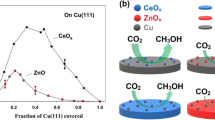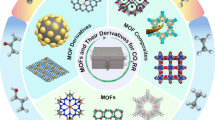Abstract
The effect of the cobalt addition on the H2S inhibition and subsequently on the polychlorinated biphenyl (PCB) hydrodechlorination (HDC) activity over Mo-based catalysts was investigated. The HDC activity over a Mo catalyst containing cobalt was much higher than that over the same Mo catalyst without cobalt. On the other hand, the HDC activity of the Co–Mo catalyst was more inhibited by H2S than that of the Mo catalyst at 300 °C. Thus, kinetic parameters were calculated using a Langmuir–Hinshelwood model to determine the reaction pathway of the H2S inhibition over Mo and Co–Mo catalysts. We found that the heats of adsorption of PCB (Aroclor® 1242) and H2S on the Co–Mo catalyst was higher than on the Mo catalyst, indicating that the sulfur-containing species adsorb more strongly on the catalyst containing cobalt. The results suggested that while the Co–Mo catalyst was more inhibited by H2S, the Mo–S bonds were more stable on this catalyst than on the solely Mo catalyst. This Mo–S bond was responsible for the stabilization of the active phase, which allowed creation of a greater amount of sulfur atoms potentially labile. Thus, that explained the better HDC activity over the Co–Mo catalyst than over the Mo catalyst, despite a greater H2S inhibition on the former.












Similar content being viewed by others
References
Blais JM, Schindler DW, Muir DCG, Kimpe LE, Donald DB, Rosenberg B (1998) Accumulation of persistent organochlorine compounds in mountains of western Canada. Nature 395:585–588
Hites RA (1990) Environmental behavior of chlorinated dioxins and furans. Acc Chem Res 23:194–201
Erickson MD (1997) Analytical chemistry of PCB’s, 2nd edn. CRC Press, Boca Raton, pp 1–96
Asante KA, Adu-Kumi S, Nakahiro K, Takahashi S, Isobe T, Sudaryanto A, Devanathan G, Clarke E, Ansa-Asare OD, Dapaah-Siakwan S, Tanabe S (2011) Human exposure to PCBs, PBDEs and HBCDs in Ghana: temporal variation, sources of exposure and estimation of daily intakes by infants. Environ Int 37(5):921–928
Domingo JL, Bocio A (2007) Levels of PCDD/PCDFs and PCBs in edible marine species and human intake: a literature review. Environ Int 33(3):397–405
Inventory of world-wide PCB destruction capacity, first issue, The Environment Programme of the United Nations, December 1998
Hitchman ML, Spackman R, Ross NC, Agra C (1995) Disposal methods for chlorinated aromatic waste. Chem Soc Rev 25:423–430
Erikson MD, Cole CJ, Flora JD Jr, Gorman PG, Haile CL, Hinsshaw GD, Hopkins FC, Swanson SE, Heggem DT (1985) PCDF formation from PCBs under fire. Chemosphere 14:855–858
Grosso M, Biganzoli L, Rigamonti L, Cernuschi S, Giugliano M, Poluzzi V, Biancolini V (2012) Experimental evaluation of PCDD/Fs and PCBs release and mass balance of a WTE plant. Chemosphere 86(3):293–299
Brunelle DJ, Mendiratta AK, Singleton DA (1985) Reaction/removal of polychlorinated biphenyls from transformer oil: treatment of contaminated oil with poly(ethylene glycol)/KOH. Environ Sci Technol 19:740–746
Roth JA, Dakoji SR, Hughes RC, Carmody RE (1994) Hydrogenolysis of polychlorinated biphenyls by sodium borohydride with homogeneous and heterogeneous nickel catalysts. Environ Sci Technol 28:80–87
Liu Y, Schwartz J, Cavallaro CL (1995) Catalytic dechlorination of polychlorinated biphenyls. Environ Sci Technol 29:836–840
Lassova L, Lee HK, Hor TSA (1999) Catalytic dechlorination of chlorobenzenes: effect of solvent on efficiency and selectivity. J Mol Catal A 144(3):397–403
Anwer MK, Spatola AF (1985) Applications of ammonium formate catalytic transfer hydrogenolysis—IV1: a facile method for dehalogenation of aromatic chlorocarbons. Tetrahedron Lett 26(11):1381–1384
Anwer MK, Sherman DB, Roney JG, Spatola AF (1989) Applications of ammonium formate catalytic transfer hydrogenation. 6. Analysis of catalyst, donor quantity, and solvent effects upon the efficacy of dechlorination. J Org Chem 54:1284–1289
Marques CA, Selva M, Tundo P (1994) Facile hydrodehalogenation with H2 and Pd/C catalyst under multiphase conditions. Part 2. selectivity and kinetics. J Org Chem 59:3830–3837
Sajiki H, Kume A, Hattori K, Nagaseb H, Hirota K (2002) Complete and truly catalytic degradation method of PCBs using Pd/C–Et3N system under ambient pressure and temperature. Tetrahedron Lett 43(40):7251–7254
Yak HK, Wenclawiak BW, Cheng IF, Doyle JG, Wai CM (1999) Reductive dechlorination of polychlorinated biphenyls by zerovalent iron in subcritical water. Environ Sci Technol 33:1307–1310
Chuang F-W, Larson RA, Wessman MS (1995) Zero-valent ironpromoted dechlorination of polychlorinated biphenyls. Environ Sci Technol 29:2460–2463
Grittini C, Malcomson M, Fernand Q, Korte N (1995) Rapid dechlorination of polychlorinated biphenyls on the surface of a Pd/Fe bimetallic system. Environ Sci Technol 29:2898–2900
Wang C-B, Zhang W-X (1997) Synthesizing nanoscale iron particles for rapid and complete dechlorination of TCE and PCBs. Environ Sci Technol 31(7):2154–2156
Jackman SA, Knowles CJ, Robinson GK (1999) SACRED—a novel catalytic process for the environmental remediation of polychlorinated biphenyls (PCBS). Chemosphere 38(8):1889–1900
Zhang P-C, Scrudato RJ, Pagano JJ, Roberts RN (1993) Photodecomposition of PCBs in aqueous systems using TiO2 as catalyst. Chemosphere 26(6):1213–1223
Arbon RE, Mincher BJ, Knighton WB (1994) γ-Ray destruction of individual PCB congeners in neutral 2-propanol. Environ Sci Technol 28:2191–2196
Arbon RE, Mincher BJ, Knighton WB (1996) γ-Ray destruction of individual PCBs in isooctane and transformer oil. Environ Sci Technol 30:1866–1871
Schmelling DC, Poster DL, Chaychian M, Neta P, Silverman J, Al-sheikhly M (1998) Degradation of poly-chlorinated biphenyls induced by ionizing radiation in aqueous micellar solutions. Environ Sci Technol 32:270–275
Chaychian M, Silverman J, Al-Shieikhly M (1999) Ionizing radiation induced degradation of tetrachlorobiphenyl in transformer oil. Environ Sci Technol 33:2461–2464
Simion AM, Miyata H, Kakeda M, Egashira N, Mitoma Y, Simion C (2013) Direct and complete cleansing of transformer oil contaminated by PCBs. Sep Purif Technol 103:267–272
Sediak DL, Andren AW (1991) Aqueous-phase oxidation of polychlorinated biphenyls by hydroxyl radicals. Environ Sci Technol 25:1419–1427
Zhang S, Rusling JF (1995) Dechlorination of polychlorinated biphenyls on soils and clay by electrolysis in a bicontinuous microemulsion. Environ Sci Technol 29:1195–1199
Huang Q, Rusling JF (1995) Formal reduction potentials and redox chemistry of polyhalogenated biphenyls in a bicontinuous microemulsion. Environ Sci Technol 29:98–103
Jain VK (1993) Supercritical fluids tackle hazardous wastes. Environ Sci Technol 27:806–808
Kim K, Kim KS, Hwan Son S, Cho J, Kim Y-C (2011) Supercritical water oxidation of transformer oil contaminated with PCBs—a road to commercial plant from bench-scale facility. J Supercrit Fluid 58(1):121–130
Hagh BF, Allen DT (1990) Catalytic hydrodechlorination. In: Freeman HM (ed) Innovative hazardous waste treatment technology. Technomic, Lancaster, p 45
Hagh BF, Allen DT (1990) Catalytic hydroprocessing of chlorinated benzenes. Chem Eng Sci 45:2695–2701
Hagh BF, Allen DT (1990) Catalytic hydroprocessing of chlorobenzene and 1,2-dichlorobenzene. AIChE J 36:773–778
Chon S, Allen DT (1991) Catalytic hydroprocessing of chlorophenols. AIChE J 37:1730–1732
Murena F (1997) Catalytic hydrodechlorination of monochlorobiphenyls using Ni–Mo/Gamma-Al2O3 sulphided catalyst. Environ Technol 18:317–324
Murena F, Schioppa E (2000) Kinetic analysis of catalytic hydrodechlorination process of polychlorinated biphenyls (PCBs). Appl Catal B Environ 27(4):257–267
Kim DI, Allen DT (1997) Catalytic hydroprocessing of chlorinated olefins. Ind Eng Res 36:3019–3026
Zhu K, Sun C, Chen H, Baig SA, Sheng T, Xu X (2013) Enhanced catalytic hydrodechlorination of 2,4-dichlorophenoxyacetic acid by nanoscale zero valent iron with electrochemical technique using a palladium/nickel foam electrode. Chem Eng J 223:192–199
Kalnes TN, James RB (1988) Hydrogenation and recycle of organic waste streams. Environ Prog 7:185–191
Brinkmann DW, Dickson JR, Wilkinson D (1995) Full-Scale hydrotreatment of polychlorinated biphenyls in the presence of used lubricating oils. Environ Sci Technol 29:87–91
Murena F, Gioia F (2002) Catalytic hydrodechlorination of decachlorobiphenyl. Appl Catal B Environ 38(1):39–50
LaPierre RB, Guczi L, Kranich WL, Weiss AH (1978) Hydrodechlorination of polychlorinated biphenyl. J Catal 52(2):230–238
Gissy H, Bartsch R, Tanielin C (1980) Hydrodesulfurization: IV. The effects of the feed components on Co–Mo/Al2O3 catalyst activation. J Catal 65(1):158–165
Yamada M, Shi YL, Obara T, Sakaguchi K (1990) Hydrogenation by CoMo/Al2O3 catalyst (Part 7) effects of catalyst pretreatment and H2S on hydrodesulphurization of benzothiophene. Sekiyu Gakkaishi 33:227–233
Singhal GH, Espino RL, Sobel JE, Huff GA Jr (1981) Hydrodesulfurization of sulfur heterocyclic compounds: kinetics of dibenzothiophene. J Catal 67(2):457–468
Kabe T, Aoyama Y, Wang D, Ishihara A, Qian W, Hosoya M, Zhang Q (2001) Effects of H2S on hydrodesulfurization of dibenzothiophene and 4,6-dimethyldibenzothiophene on alumina-supported NiMo and NiW catalysts. Appl Catal A Gen 209(1–2):237–247
Vrinat ML (1983) The kinetics of the hydrodesulfurization process—a review. Appl Catal 6(2):137–158
Afanasiev P (2010) The influence of reducing and sulfiding conditions on the properties of unsupported MoS2-based catalysts. J Catal 269:269–280
Puello-Polo E, Brito JL (2010) Effect of the activation process on thiophene hydrodesulfurization activity of activated carbon-supported bimetallic carbides. Catal Today 149(3–4):316–320
ASTM D4059 (1991) Standard test method for analysis of polychlorinated biphenyls in insulating liquids by gas chromatography. ASTM, Baltimore
Choi YH, Lee WY (2000) Effect of Ni loading and calcination temperature on catalyst performance and catalyst deactivation of Ni/SiO2 in the hydrodechlorination of 1,2-dichloropropane into propylene. Catal Lett 67:155–161
Park C, Menini C, Valverde JL, Keane MA (2002) Carbon–chlorine and carbon–bromine bond cleavage in the catalytic hydrodehalogenation of halogenated aromatics. J Catal 211(2):451–463
Keane MA (2002) Interfacial applications in environmental engineering. Marcel Dekker, New York, p 231
Gampine A, Eyeman DP (1998) Catalytic hydrodechlorination of chlorocarbons. 2. Ternary oxide supports for catalytic conversions of 1,2-dichlorobenzene. J Catal 179(1):315–325
Ohtsuka Y (1989) Influence of hydrogen chloride treatment on the dispersion of nickel particles supported on carbon. J Mol Catal 54(2):225–235
Hoang-Van C, Kachaya Y, Teichner SJ, Arnaud Y, Dalmon JA (1989) Characterization of nickel catalysts by chemisorption techniques, x-ray diffraction and magnetic measurements: effects of support, precursor and hydrogen pretreatment. Appl Catal 46(2):281–296
Acknowledgments
This work was financed by research grants from FONACYT (G-2005000444), and PDVSA (Contract No. 2005-00051/2005-024).
Author information
Authors and Affiliations
Corresponding author
Rights and permissions
About this article
Cite this article
De La Rosa, M., Betancourt, P., Díaz, A. et al. Effect of H2S inhibition on the hydrodechlorination of polychlorinated biphenyls over Mo/Al2O3 and Co–Mo/Al2O3 catalysts. Reac Kinet Mech Cat 111, 277–292 (2014). https://doi.org/10.1007/s11144-013-0635-5
Received:
Accepted:
Published:
Issue Date:
DOI: https://doi.org/10.1007/s11144-013-0635-5




